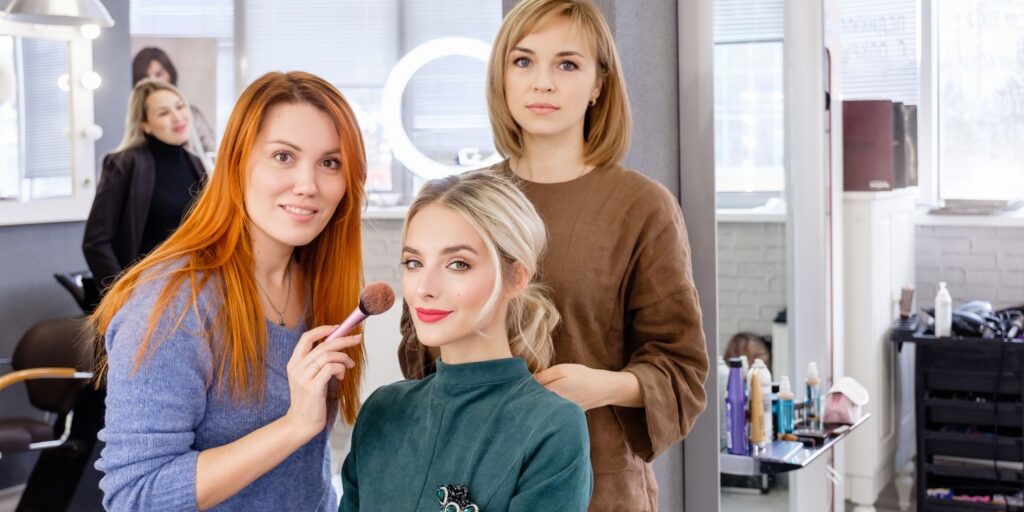If you’re an aspiring beauty therapist or have a passion for the beauty industry, you can turn that passion into a successful career by opening a beauty salon and being your own boss.
In this article, we’ll take you through the key steps to opening a beauty salon. Some of the main items on your checklist will be to create a solid business plan, register as a limited company, understand beauty industry regulations, and get the right business insurance. Let’s get started.
1. Determine your beauty services
Start by deciding which beauty services you want to focus on in your salon. Consider any of your existing skills or qualifications that you may wish to specialise in.
Even though beauty salons typically offer a wide range of services – from hairdressing and beauty therapy, to massages and manicures – you may prefer to concentrate on one or two and make your new business stand out from the crowd.
As a small salon owner, you might also find it more manageable by starting with just a few services and expanding your offering as your business grows. This is especially useful if you’re starting your beauty salon on your own.
However, if you have a business partner (or partners) from day one, then you may have the capacity to include additional beauty services before you build up a team.
2. Calculate your setup costs
Now that you know the services your beauty salon will offer, you need to weigh up your setup costs.
Business premises
Your business location will be one of your biggest expenses. According to Bionic, the average monthly rent of a commercial unit in Greater London, the most expensive area to run a business in the UK, is £11,400. Meanwhile, the cheapest location to rent a commercial space in the country is Morayshire, Scotland, with an average monthly rent of £4,919.
When choosing a location for your beauty salon, you won’t necessarily have the luxury of simply opting for the town with the lowest property prices. It should be somewhere local to you, convenient for your customers to get to, and with high footfall.
Alternatively, you can reduce these costs significantly by running your beauty salon from home or going mobile. If you have the space, you can convert a room or outbuilding into a beauty salon (with the landlord’s permission if you’re renting), or travel to your clients’ homes instead.
Decor and furnishings
If you’re opting for an empty rental unit, you’ll need to invest in decor and furnishings. Presuming that the space is in good condition, this will typically include external signage, tables, chairs, mirrors, storage cabinets, a reception desk, and even coat hooks.
You’re also likely to need specialist furnishings like washbasins (ranging between around £200 to £11,000 per unit) or massage tables (ranging between £400 and £1,500). Don’t forget to factor in the installation costs of some of these items (e.g. plumbing).
As well as ensuring adequate facilities in your beauty salon, remember to add a personal touch to the decor, that will make your beauty salon pleasant, inviting, and unique.
Beauty equipment
Another key expense will be your beauty equipment. An all-new set of salon tools could cost you between £5,000 and £30,000. It all depends on the services you’re going to offer, whether you’ll be buying or leasing your equipment (or a mixture of both), and whether you have any equipment already.
You also need to consider inventory. For example, if you’re going to offer nail treatments, you’ll need a healthy supply of nail polishes, or if you’re going to offer hair styling services, you’ll need a good selection of hair dyes.
Finally, you may choose to sell retail products in your beauty salon to bring in extra revenue. These could be hair care products or styling tools, for instance, in which case you’ll need a continuous stock of these items.
To run a successful beauty salon, your products and tools should be of high quality. Not only will this ensure the health and safety of your customers, but it will also help establish trust, loyalty, and value for money, if your visitors are happy with the service quality they receive.
Admin tools
You’ll need certain admin equipment to assist you in running your business daily. That includes taking payments, booking appointments, sending appointment reminders, storing customer information, and managing your inventory.
One of the main tools you’ll need is a point of sale (POS) register. Depending on the provider and type of hardware you choose, basic POS systems start at around £150 plus VAT on top of a monthly subscription of around £50.
If they’re not already included in your POS system, you will need additional software. Platforms like Fresha and SimplyBook.me are great all-in-one options. With free plans available, you can arrange appointments, plan your marketing promotions, and access performance analytics all in one place.
3. Choose a pricing model
The next step is to decide how much you should charge for your beauty services. To work this out, you need to determine:
- How much it costs you to source your products and equipment
- The labour costs of administering your beauty services
- Your ideal profit margin
Essentially, the combination of points 1 and 2 is your break-even value. You should outline this figure for each type of beauty service you offer as they will all vary.
Then, apply a suitable profit margin. To find this out, assess your local competition. Research other beauty salons in your area and see how much they charge for similar beauty services.
Your final consumer prices should be competitive, whilst generating healthy revenue for your business. For example, if a competing beauty salon charges £20 for a manicure, but it costs you £20 to source the products for this service, that’s too low and you won’t be making any money. So, you might need to charge £25 or £30.
Remember to research relevant competitors – other small, local businesses. Well-known and established brands are not comparable.
4. Create a business plan
A solid business plan allows you to plan your company’s first few years. It’ll map out your successes and how to achieve them, as well as potential pitfalls and how to avoid them.
This is done by outlining your financial projections, conducting competitor analysis, defining your target market, and planning a marketing strategy. All these key components come together to show you just how viable your beauty salon idea is.
When you’re ready to raise capital, a business plan will also assist you in bringing new investors and lenders on board. Whether you try crowdfunding or apply for a bank loan, potential lenders will want to see a comprehensive business plan, showing them how successful (or risky) your business is.
For detailed guidance on how to write a business plan, see our blog on ‘How to write a business plan as a start-up.’
5. Register as a limited company
The next step is to register your beauty salon as a limited company. Compared to a sole trader model, this business structure can give you crucial legal protection and financial advantages.
Firstly, a limited company is a separate legal entity. This means that, in the eyes of the law, you (the owner) are independent of the business and your personal assets are separate and, therefore, protected by ‘limited’ liability. So, if a private company limited by shares encounters financial trouble, the owners are only liable up to the amount paid for their shares. By contrast, there is no distinction between a business and a sole trader – they are one and the same.
Secondly, there’s an element of credibility and prestige that comes with limited companies. This is because UK-registered companies are regulated by the Companies Act 2006, giving customers, clients, partners, and lenders confidence and peace of mind when interacting with your business.
Finally, there are important taxation advantages for limited companies. Unlike sole traders, limited companies pay Corporation Tax (as opposed to Income Tax), which is charged at 19%-25%, depending on your level of profits. Meanwhile, sole traders pay Income Tax of up to 45% on their earnings (or up to 48% in Scotland).
Limited company owners (who are also directors) also have the option of drawing a mixture of dividend payments and a director’s salary, giving them the most tax-efficient way to pay themselves.
While operating as a sole trader may seem easier in the short term, registering your beauty salon as a limited company is a must to keep yourself and your new business safe.
Register your beauty company with 1st Formations for as little as £52.99 in just 4 simple steps.
6. Understand beauty industry regulations
As a beauty salon owner, there are several industry laws, regulations, and standards that you’ll need to adhere to.
Product safety
As per the Cosmetic Products Enforcement Regulations 2013, you are responsible for the safety of your products – they “must be safe for human health under normal and reasonably foreseeable conditions of use.”
As your customers will be coming into physical contact with your products, it’s paramount that they are safe. This is to avoid allergic reactions, harmful effects, or other accidents in your salon.
To ensure your products are safe and handled correctly, you should always wear protective clothing (like gloves, an apron, and a face mask) when using harsh chemicals such as hair dye or bleach. Customers should also be provided with protective wear where necessary.
You should always familiarise yourself with the ingredients used in your products, and consult the manufacturer about the safest way to handle and store them.
Your salon will also need to be fitted with extractor hoods and downdraught tables if any of your products produce harmful fumes.
Equipment maintenance
All of your beauty tools and equipment (e.g. hair dryers, curing lamps, facial steamers) must be checked and maintained regularly, to ensure they are safe and used hygienically.
Particularly since COVID-19, all equipment which is used by multiple customers must be properly cleaned between every use. However, you should provide sterile, single-use tools where possible.
If you offer automatic spray tanning services in your beauty salon, you’ll need to pay extra attention to the risk of legionella bacteria. This can build up from the stagnant water held in small tanks that activate the tanning booth. You must ensure that the water is clean and the booth sanitised after each customer.
First aid
You will need to have an adequately stocked first aid kit in your beauty salon at all times. Unless you have a dedicated health and safety officer, you are responsible for maintaining your first aid kit and logging any incidents that happen in your salon.
To keep your beauty salon safe and minimise the risk of injuries, it’s worth conducting regular health and safety audits to keep you and your customers safe.
You (and your future employees) must also be first aid trained. This certification is valid for 3 years and should be renewed regularly.
Business licences
To legally provide beauty treatments, you’ll need to obtain certain licences. The licences relevant to you will depend on the services you offer and your local authority, as each one is different.
For example, a beauty salon in England offering massage therapy will need to obtain a Massage and Special Treatment Premises licence. Or if you want to play music in your beauty salon, you’ll need a music licence from PPL.
You can check which licences you might need on the gov.uk website. However, this may not include them all, so be sure to check with your local authority for the correct guidance.
7. Get business insurance for your beauty salon
Your beauty salon should have the following types of business insurance:
- Professional treatment liability insurance: Protects you from third-party claims for illness, injury, or damage caused by your treatments or employees.
- Public liability insurance: Protects you from the legal costs of injuries and accidental damage caused to the general public due to your work.
- Portable equipment insurance: Protect your beauty equipment in case it’s stolen, lost, or damaged.
- Product liability insurance: Protects you from third-party claims for injuries or damage caused by faulty equipment. For example, if you damage a customer’s nails due to a faulty curing lamp.
- Commercial property insurance: Protects your beauty salon (if it’s a standalone unit) from damage and covers repair costs (e.g. burglary or a burst pipe).
- Contents cover: Protects your stock, furniture, and fittings from theft or damage.
- Directors’ and officers’ insurance: As a company owner, you must comply with certain duties and obligations. This policy personally protects you if you’re accused of breaching those duties. Find more details in our ‘Role and duties of a company director’ blog.
Once you take on employees, you will also be required to obtain Employer’s Liability insurance. On top of these, you may find business interruption, invoice, and legal protection insurance useful for your beauty salon.
8. Promote your beauty business
The final step in our guide is to promote and grow your beauty brand:
Set up a website
A website is a must – the digital home of your business. This is the first place that potential customers will land when looking for beauty salons.
Your website should be easy to navigate, communicate your services and prices clearly, and how to get in touch. You should also share your entrepreneurial journey on your website – it adds a personal touch and your visitors are more likely to connect with and support a small, local business.
Setting up a website doesn’t have to be expensive. When you register your beauty business through 1st Formations, you’ll get a free domain name for your website. Alongside this, platforms like WordPress and Wix offer free and low-cost web hosting plans.
Register a Google Business Profile
To ensure your business appears on Google Maps, you should register a Google Business Profile for free, once your website has been created. This will allow local customers to find your beauty salon when looking for local beauty salons on Google.
Social media
Another essential is creating a social media presence. Not only are most platforms, such as Instagram and Facebook, free for businesses to use, but they are a powerful gateway to your target audience and marketing your services to them.
Be sure to link your website to your social media channels, use the right hashtags to deliver your content to relevant users, and run sponsored advertising to bring your new beauty salon to the forefront of your customers’ feeds.
Word of mouth
For services such as beauty, word of mouth remains an incredibly effective promotional tactic. When customers have positive, valuable experiences, they’ll be excited to share them with their friends and family – and even post them on social media.
Once your clientele starts to build up and people are pleased with your services, they’re likely to recommend you to others and spread awareness about your beauty brand.
Conclusion
So there you have the 8 steps to opening a beauty salon in the UK. There are many different things to consider and prepare for when entering this sector; the startup costs can be substantial, and the industry rules and regulations are complicated.
Follow our guide to opening your beauty salon, to ensure you’ve got all bases covered. Thanks for reading. Please post any questions or comments below.


















Join The Discussion